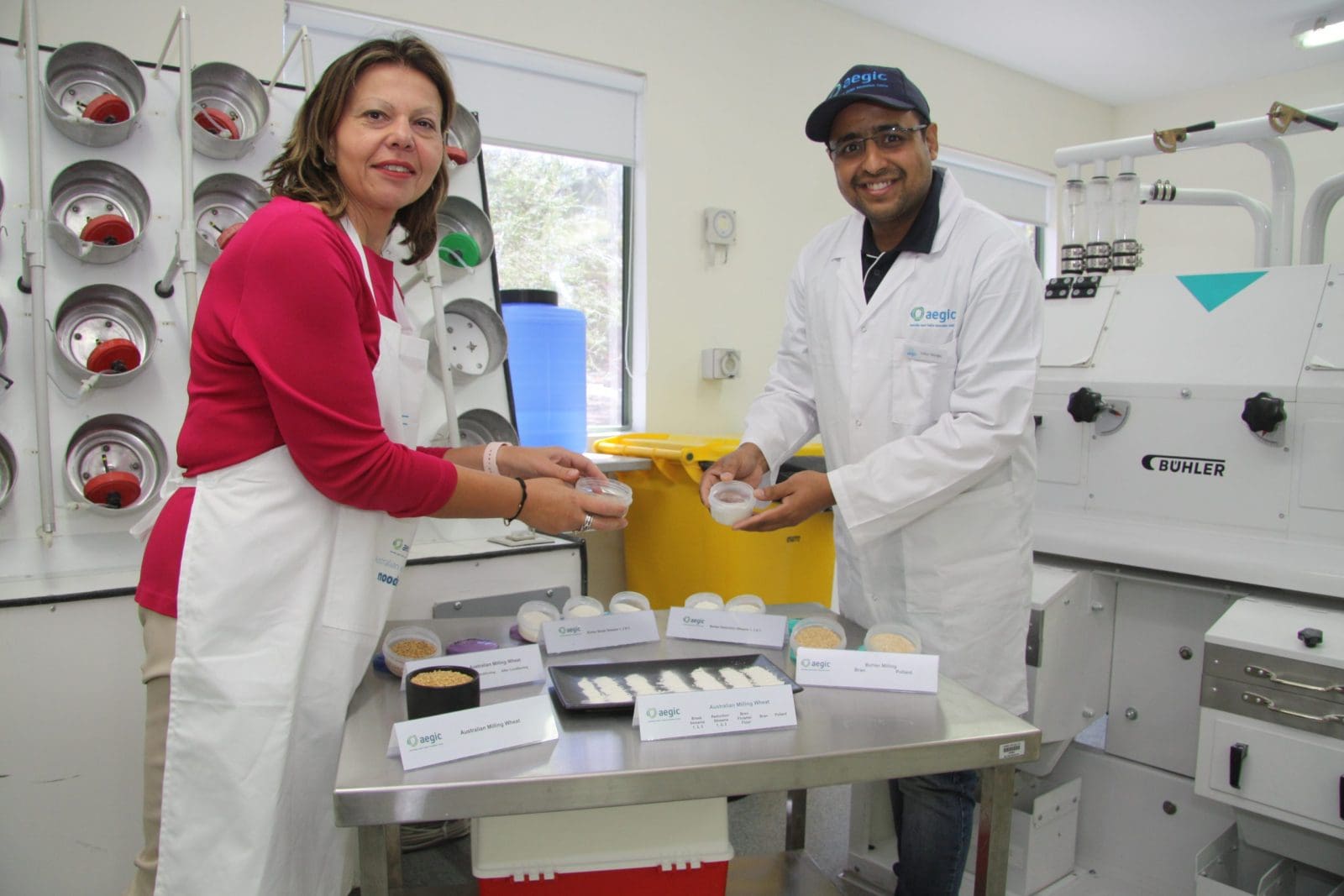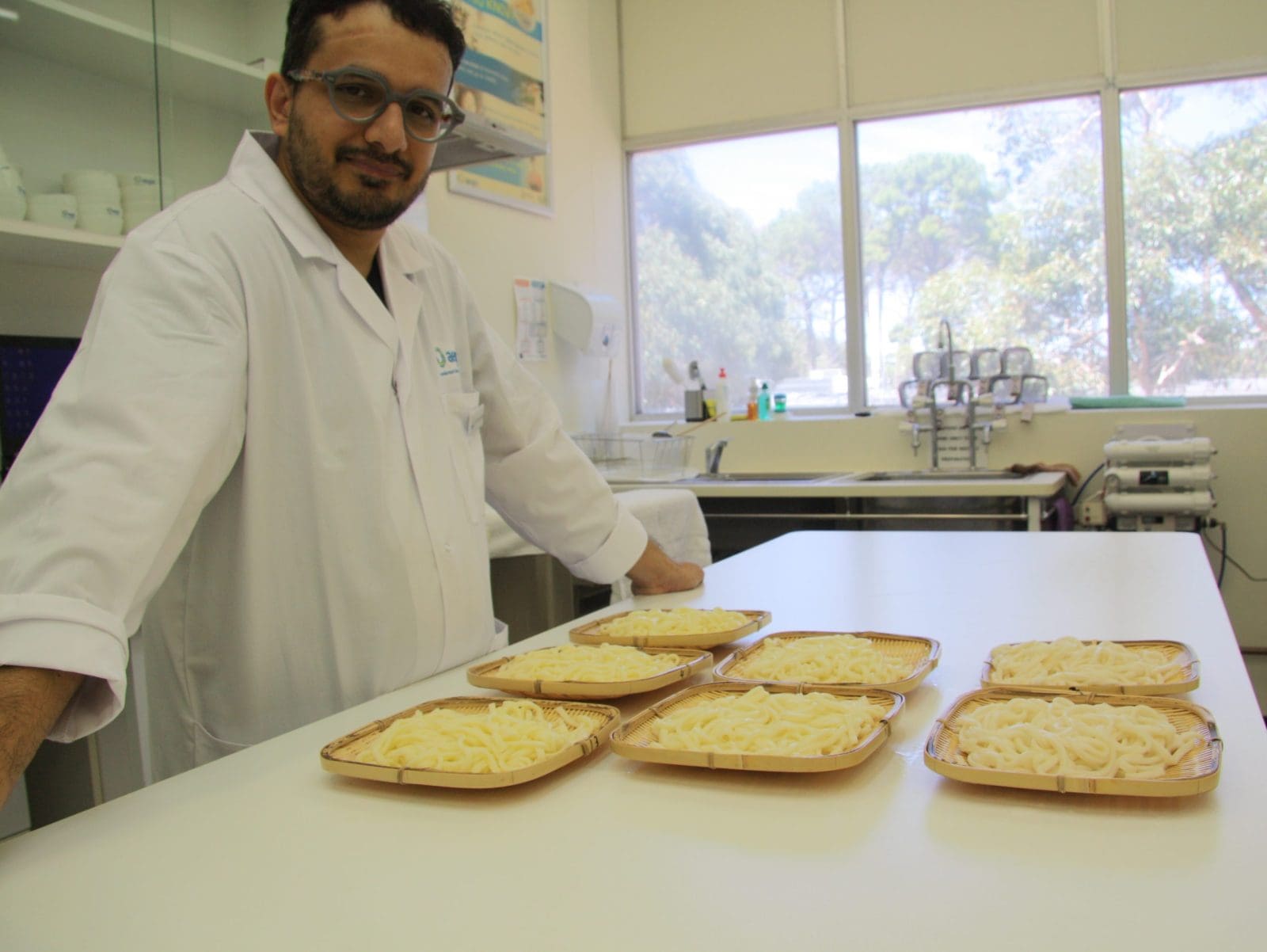
AEGIC Perth technicians Braiden Hudson, Cassandra Kok and Junhong Ma bake and test products using different varieties of wheat to help ensure Australia is meeting customer requirements.
EVER-CHANGING consumer trends and relentless global competition mean the Australian grain industry can take nothing for granted.
It’s the reason why the Australian Export Grains Innovation Centre has an ongoing dialogue with offshore customers that ensures varieties are being bred and grown to satisfy the needs of millers.
At both of AEGIC’s laboratories the milling of Australian wheat to match specifics from Asian noodle and bread markets has been a focus, but scope for its cookie and cake-baking segment is also being explored.
AEGIC’s Wheat Quality Technical Seminar series is now in full swing, with events this month taking place in Jakarta, Kuala Lumpur, Bangkok, Ho Chi Minh City, Hanoi, and Manila.
At all of them, the AEGIC team will be engaging with representatives from each country’s milling, baking and noodle-manufacturing industries, and encouraging them to give Aussie flour a try for their sweet-baking needs.
In addition to the five-nation tour, AEGIC research scientist Siem Siah recently presented on soft wheat opportunities at the Australian Grains Industry Conference Asia’s Jakarta and Shanghai programs.
Soft wheat ready for resurgence
In decades past, Australia produced a considerable amount of soft wheat for use in the domestic baking industry.
Low in protein and high yielding, it was grown primarily on irrigated country in southern New South Wales, and in higher-rainfall regions of south-eastern Australia, with Rosella the star variety.
By 2012, soft wheat had fallen to around 4pc of the domestic wheat market to reflect more lucrative production options for growers who had switched to Australian Premium White, Australian Hard, and durum, varieties.
All classifications have good export and domestic demand profiles, extending to the stockfeed market for off-spec grades which can be produced during excessively wet or dry seasons, and have displaced soft wheat in many grower rotations.
AEGIC wheat quality technical markets manager Larisa Cato says soft wheat has potential to expand in WA as well as eastern Australia, and increased exports are in AEGIC’s sights.
American soft wheat is dominant in the region but Asian flour millers have told AEGIC they are interested in sourcing from Australia.
“Our advantages are our clean and dry environment; our low-moisture grain immediately speaks value to our customers,” Dr Cato said.
AEGIC intelligence says Australia’s proximity to South-east Asia, and potential for exporters to ship combination cargoes of hard and soft wheat suited to customer needs, could all help build the appeal of Australia as a soft wheat supplier.
It also indicates the annual growth rate in South-east Asia for cakes and cookies is twice that of noodles, which account for most of the market’s current Australian wheat usage.
AEGIC analysis estimates that soft wheat demand in South-east Asia alone could be more than 3 million tonnes by 2030.
Three breeding companies — InterGrain, Australian Grain Technologies, and LongReach — have already increased their investments in breeding soft wheat in WA, where the segregation could be reintroduced in Australia’s biggest wheat-exporting state.
In south-eastern Australia, Dr Cato said export demand could see soft wheat production rebuild from its current state.
“It’s tiny and it’s domestic.”
AEGIC first went public in 2018 about its aim to take some soft wheat market share from North America.
The project is led by Dr Siem Siah, who is based in AEGIC’s Sydney labs, home of the former Bread Research Institute of Australia.

AEGIC wheat quality technical markets manager Larisa Cato and milling specialist Ankur Mangla in the Perth facility’s milling section.
Just as export market development is a work in progress for AEGIC, so is the building of a database from its baking laboratory to show potential customers how existing Australian varieties can be milled into flour ideal for Asian cakes and cookies.
That database covers characteristics such as how much the cookie dough spreads during baking, with a thinner cookie preferred.
“Once we establish what we need, we have to assess each new variety before we can say it is good for making cookies and cakes.”
Project leader Dr Siah is working with Grains Australia and breeding programs in WA to create a new export soft wheat class targeting Asian markets.
The goal is to ensure that the new soft wheat varieties will meet export markets’ quality requirements.
Dr Cato, who is based at AEGIC’s Perth facility, said the work of AEGIC’s staff in Australia is crucial in determining the marketable properties of each wheat variety.
“That’s where the team comes in with milling, moulding and sheeting.”
Both sites mill grain and have baking laboratories, with the Perth site the hub of AEGIC’s noodle testing.
Noodles made to order
AEGIC is funded by the Western Australian Government, and by Grains Australia, an initiative of the Grains Research and Development Corporation formed to look after industry-good functions.
That includes the classification of varieties of wheat, barley and oats for their various purposes, and the transmission of AEGIC market intelligence and quality targets to seed-breeding companies.
Yellow alkaline noodles, with South East Asia as a key export region, and Japan for udon noodles are the two premier markets for Australian wheat, while Asia’s instant noodle market is generally Australia’s volume customer for milling wheat.
The Japan udon noodle market is unique, in that noodle wheat (ANW and APWN) is only grown in WA.

AEGIC Perth technician Kishor Sharma Regmi with udon noodles made from flour milled on site.
AEGIC hosts many visitors in order to keep up with consumer demands in these noodle markets, and to ensure Australia is breeding and growing wheat to suit.
The visitors include trade delegations and regular panels which assess noodles made from flour milled on site.
Quality parameters include texture, appearance, mouthfeel, and colour; on the latter, Dr Cato said Australia has a distinct advantage.
“We are the only 100pc white wheat supplier to our markets,” Dr Cato said.
In the case of Japan, AEGIC works closely with the Grain Industry Association of WA and CBH as WA’s leading bulk handler and exporter to engage with Japan’s flour-milling industry regularly, including hosting visiting Japanese experts to assist with sensory evaluation.
The goal is to maintain WA’s position as the leading supplier of wheat to make udon noodles that are not too yellow, too dull, or too pale, and of the desired texture.
Dr Cato said some outdated varieties like Nyabing are kept to produce a noodle that provides a visual marker.
“We use it so we know when the yellow becomes too yellow.”
“The breeders have the genetic markers to include in varieties, and we have to tell them which ones the markets want.”
Grain Central: Get our free news straight to your inbox – Click here

HAVE YOUR SAY